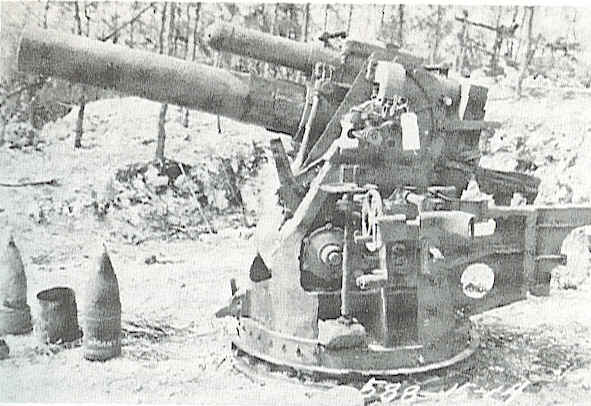|
Constructed of monobloc barrel with a screw breech. Actual bore diameter was 20.32 cm (8.0"). |

20 cm/12 (8") Short gun used as coastal
defense battery
|
| .
|
|
Constructed of monobloc barrel with a screw breech. Actual bore diameter was 20.32 cm (8.0"). |

20 cm/12 (8") Short gun used as coastal
defense battery
|
| .
|
| Designation | 20 cm/12 (8") Short Gun |
| Ship Class Used On | Merchant ships over 5,000 grt |
| Date Of Design | 1943 |
| Date In Service | 1943 |
| Gun Weight | 1,390 lbs. (630 kg) |
| Gun Length oa | 99.21 in (2.520 m) |
| Bore Length | 96.0 in (2.438 m) |
| Rifling Length | 78.1 in (1.984 m) |
| Grooves | (32) 0.059 in deep x 0.654 in (1.5 mm x 16.61 mm) |
| Lands | 0.131 in (3.34 mm) |
| Twist | Increasing RH 1 in 30 to 1 in 13 |
| Chamber Volume | 891 in3 (14.6 dm3) |
| Rate Of Fire
(see Note) |
4.5 rounds per minute |
| Note: ROF from "Naval Weapons of World War Two" but as the mountings for these guns were hand-trained and elevated and needed to return to a low angle for loading, I believe the rate of fire to be overstated. | |
| Type | Separate |
| Projectile Types and Weights
(see Note) |
HE - 103.6 lbs. (47 kg)
IS - 103.6 lbs. (47 kg) |
| Bursting Charge | 30.0 lbs. (13.6 kg) |
| Projectile Length | 22.4 in (56.9 cm) |
| Propellant Charge | 4.41 lbs. (2 kg) |
| Muzzle Velocity | 1,001 fps (305 mps) |
| Working Pressure | 4.1 to 4.4 tons/in2 (650 to 700 kg/cm2) |
| Approximate Barrel Life | 2,000 rounds |
| Ammunition stowage per gun | N/A |
| Note: Two kinds of incendiary shrapnel (IS) were supplied. | |
| Elevation | With 103.6 lbs. (47 kg) AP Shell |
| Maximum range | 6,890 yards (6,300 m) |
| Ceiling @ 75 degrees | 10,830 feet (3,300 m) |
| Designation | Single Mountings |
| Weight | 4 tons (4.1 mt) |
| Elevation | -15 / +75 degrees |
| Elevation Rate | 8 degrees per second (manual operation) |
| Train | 360 degrees (?) |
| Train Rate | 8 degrees per second (manual operation) |
| Gun recoil | N/A |
| Loading angle | about 10 degrees |
| Note: These mountings are described as being heavy and slow, which may mean that the firing rates are overstated, especially at high elevations. Ammunition supply relied upon the ships' cargo hoists and simple derricks. | |